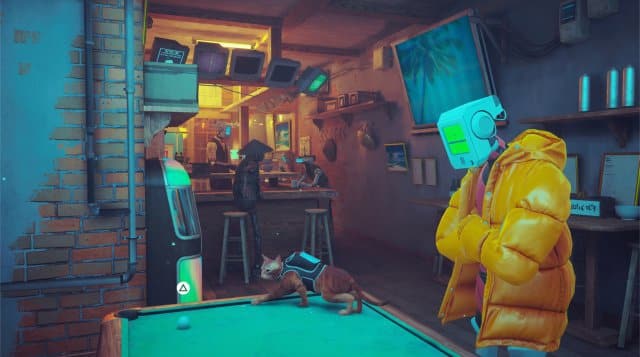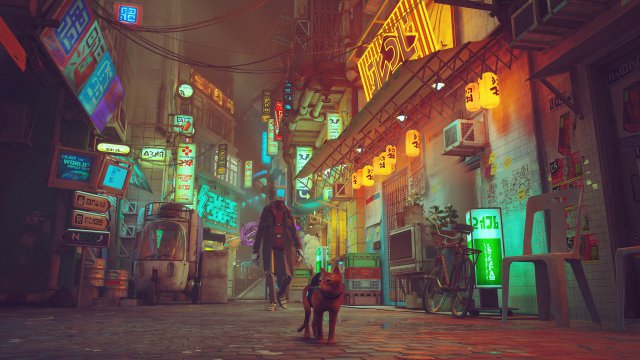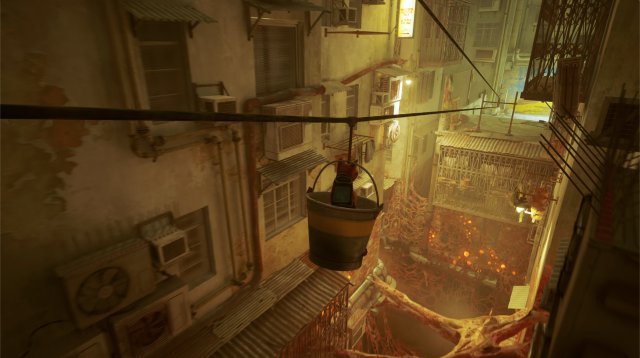Stray – test, action-adventure

reluctant hero
Stray (English: to stray = stray) begins quite harmlessly: together with other cats, the animal hero enjoys the supposed dissolute life of a free-living kitty in the big city. His squad trundles through the sewers and balances over planks or pipes, people slurp from puddles or curl up comfortably under a roof when there’s thunder and lightning. A broken pipe later, the idyll is gone: Our kitten rumbles down and licks his battered limbs several floors below. Visibly limping and without the safety of your cat buddies, the dingy backdrop of the city suddenly seems menacing. What now? The character is not a sore muscle with a gun, as other game makers might stage an action-adventure with a feline hero. You control a slim stray who mainly uses his claws to work on carpets and sofas, at the push of a button he emits a pitiful meow. That way you can’t get locked lattice doors open and those nasty, tick-like crawling critters scurrying through the sewers are attracted to it too!
From this moment on, as a player, you realize in which world you are thrown in Stray: a vertically laid out city, somewhere between a fictional cyberpunk metropolis and an Asian mega-city. With a shabby garbage and sewage tract, winding courtyards, accessible roofs. In the “beautiful” part there is a lively hustle and bustle, the robot population goes about their work – the androids with the sometimes smiling, sometimes sad screen faces sit at the ramen noodle shop, run a bar or present the latest collection in the fashion boutique. Stray serves you several of these quite open level areas, there you look for the best way from A to B, explore the localities and do small tasks. Elsewhere it becomes more linear and dramatic: our little tiger rushes through the lower floors of the city, pursued by disgusting bugs called “Zurks”, jumping nimbly over poisonous puddles or trying to sneak past flying security drones.

Stray looks amazing for an indie game. The flood of details is particularly great in this market place.
There is open world light here, stealth light there and a bit of action light as well. In general, the playful demands are limited over the entire six to eight hours: your cat will die a few deaths, but you will mostly have an easy time even without choosing the level of difficulty. That’s because the developers didn’t spice up some elements with sophisticated mechanics even where it should have: A balancing mini-game when hopping on thin bars? A shadow or visibility indicator on the stealth inserts? A free hopping function to move around the city? All of that doesn’t exist. Instead, to stay with the last example, you are tied to context-sensitive hops. That means: Whenever your kitty has a jump option, the X button will appear. For example, if you fly next to a wall, the X symbol at the top of the wall edge will move next to you – it actually looks very smooth. If you press the button, the stray will be up with an elegant hop. This is how your Stray maneuvers in the half-open city areas from the lowest alley over pipes, boards, balconies, air conditioning systems & Co. to the highest panorama terrace. That only sounds semi-comfortable, but in practice it works surprisingly well. Stray will no longer be a skill-based platformer la Super Mario, but the French team has solved the locomotion issue well.
Is this still indie?

In some places you can use bucket elevators & Co. – and at the same time have a view of the disgustingly overgrown lower town.
In general, it’s amazing how competently made and how high-quality the whole game looks – after all, it’s the debut work of an unknown French studio. With publisher Annapurna, you have a competent company behind you, but not a financier of the size of an EA, which, for example, ensured a very high production quality for the Unravel games or It Takes Two. Stray’s graphics range from very neat to downright awesome, which is also surprising. Especially the adorable animations of the cat and the tangle of signs, cables and shops in the main streets of the city are awesome. There are also lots of excellent textures, squeaky clean modeled objects in the rooms; delicately shimmering Plexiglas, glaring neon tubes and noble reflections on metallic objects. In terms of controls, the game doesn’t excel that much, but there’s almost nothing to complain about here either. On the sound side, to complete the technical triumvirate, Stray relies on likeable meowing, robotic babble (which isn’t annoying though), solid sound effects and a relaxed soundtrack that stays comfortably in the background.
Reference-www.4players.de